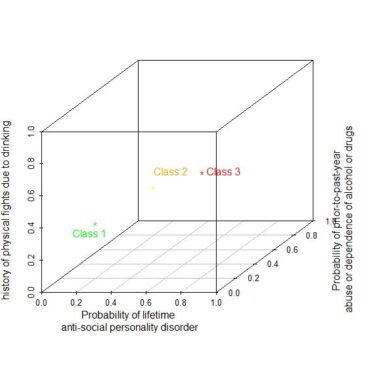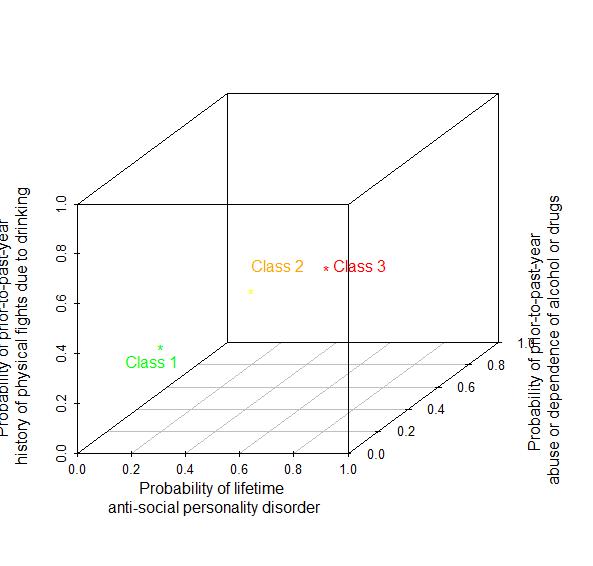During 2002, Blaszczynski and Nower proposed that there are
three pathways to problem and pathological gambling. In their first pathway,
problem gambling develops as a matter of behavioral conditioning, not as a
matter of psychopathology. In their second pathway, factors such as mood disorders,
poor coping skills, and traumatic life
events contribute to the production of an “emotionally vulnerable gambler” who
gambles to relieve pain (Blaszczynski & Nower, 2002). In their third pathway, emotional
vulnerability combines with impulsivity and attention and personality disorders
to create many problems, including gambling. Today’s WAGER reports on research (Nower, Martins, Lin, & Blanco, 2012) that searches for symptom
clusters corresponding to these three pathways using data from of the National
Epidemiological Survey on Alcohol and Related Conditions.
Methods
- The study used data from the U.S. National
Epidemiological Survey on Alcohol and Related Conditions (NESARC) (Grant & Dawson, 2006).- The data were reduced to include only and all
disordered gambling participants (n =
581).[1] - The researchers analyzed participants’ responses
to questions about alcohol use, tobacco use, other medications and drugs,
psychological disorders, family history of addiction and psychological
problems, gambling, medical conditions and victimization. -
- The data were reduced to include only and all
- The researchers used latent
class analysis to identify subgroups within the NESARC disordered gambling
population based on a combination of 17 clinical indicators.- They
evaluated models with between 1 and 5 classes to identify the optimal model
(i.e. the model that best fit the observed data). - The researchers identified the optimal model by
examining statistics (i.e. log-likelihood
statistics, AIC
and BIC)..
- They
Results
- Out of the five models, the optimal one was the
one with three classes. - The probability that someone in Class 1 (n =
295) had a prior-to-past-year experience with a substance use disorder was 55%.
The probabilities for most other indicators of psychological problems were
under 10%. Participants in this group reported relatively high mental health
functioning.- Based on these clinical indicators, researchers
suggested that Class 1 corresponds to the first Blaszczynski and Nower (2002) pathway.
- Based on these clinical indicators, researchers
- The probability that someone in Class 2 (n =
117) had a prior-to-past-year experience with a substance use disorder was 74%.
Other probabilities of note were those of physical fights due to drinking
(33%), anti-social personality disorder (23%), panic disorder or general
anxiety disorder (22%), and onset of the first episode of depression in the
past year (22%).- Because of the elevated probabilities of signs
of emotional vulnerability, the researchers suggested that Class 2 was
generally consistent with the second Blaszczynski and Nower (2002) pathway.
- Because of the elevated probabilities of signs
- The probability that someone in Class 3 (n =
169) had a prior-to-past-year experience with a substance use disorder was 78%.
Additionally, the probabilities of a history of antisocial personality
disorder, past-year substance abuse disorder, and involvement in drinking-related
physical fights were 49%, 43% and 40%, respectively.- Class 3 had the highest probabilities out of the
three classes for 12 out of the 17 indicators. The researchers drew parallels
between Class 3 and the third Blaszczynski and Nower (2002) pathway.
- Class 3 had the highest probabilities out of the
- Figure 1 is a 3-dimensional graph with the
probabilities for prior-to-past-year alcohol abuse, prior-to-past-year history
of drinking-related physical fights, and lifetime anti-social personality
disorder, for the three classes. These three example indicators and the three
locations in space illustrate the differences between Class 1, Class 2, and
Class 3.
Figure 1: Probabilities of lifetime anti-social personality
disorder, prior-to-past-year abuse or dependence of alcohol or drugs, and
prior-to-past-year history of physical fights due to drinking, for each of the
three classes. Adapted from Nower et al., 2013.
Limitations
- It is not possible to test some aspects of the
three-pathway model. For example, Blaszczynski and Nower (2002) proposed that
the pathways are dependent on the age at which individuals are introduced to
gambling. However, these data was not part of the NESARC. - Likewise, it is not possible to determine from
the data which symptoms of drug abuse and other issues preceded the onset of
gambling problems and which ones followed it. This order of events is necessary
for distinguishing among the pathways.
Conclusion
The three classes found in the latent class analysis
somewhat correspond to the three pathways outlined in Blaszczynski and Nower’s (2002)
earlier work. They represent different levels of complicating factors that can
interfere with or obstruct attempts at intervention or treatment for disordered
gambling. If clinicians can identify their patients’ pathways, they might be
able to adapt or tailor different treatment programs to their own special needs
and personalities.
– Matthew Tom
What do you think? Please use the comment link below
to provide feedback on this article.
References
Blaszczynski, A., & Nower, L. (2002).
A pathways model of problem and pathological gambling. Addiction, 97(5),
487–499. doi:10.1046/j.1360-0443.2002.00015.x
Grant, B.
F., & Dawson, D. A. (2006). Introduction to the national epidemiologic
survey on alcohol and related conditions. Alcohol Health & Research
World, 29(2), 74.
Nower, L.,
Martins, S. S., Lin, K.-H., & Blanco, C. (2012). Subtypes of disordered
gamblers: results from the National Epidemiologic Survey on Alcohol and Related
Conditions. Addiction (Abingdon, England). doi:10.1111/add.12012
[1]
All participants were asked if they had gambled at least five times in any 1
year of their lives. Those who responded affirmatively and then met three or
more DSM-IV criteria for pathological gambling were classified as disordered
gambling participants.





